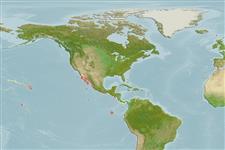>
Ovalentaria/misc (Various families in series Ovalentaria) >
Pomacentridae (Damselfishes) > Microspathodontinae
Etymology: Stegastes: Greek, stegastos, -e, -on = covered (Ref. 45335).
More on author: Gilbert.
Environment: milieu / climate zone / depth range / distribution range
Ökologie
seewasser riff-verbunden; standorttreu; tiefenbereich 1 - 15 m (Ref. 9334). Tropical; 30°N - 1°S
Eastern Central Pacific: Mexico, including the Revillagigedo and Guadalupe islands.
Size / Gewicht / Alter
Maturity: Lm ? range ? - ? cm
Max length : 14.0 cm SL Männchen/unbestimmt; (Ref. 9334); max. veröff. Alter: 19 Jahre (Ref. 52465)
Rückenflossenstacheln (insgesamt): 12; Rückenflossenweichstrahlen (insgesamt): 14-16; Afterflossenstacheln 2; Afterflossenweichstrahlen: 12 - 14. Usually with 16 dorsal spines and 12 gill rakers on the lower limb of the first arch (Ref. 7247).
Adults inhabit coral and rocky inshore reefs (Ref. 9334). Omnivorous (Ref. 9334). Oviparous, distinct pairing during breeding (Ref. 205). Eggs are demersal and adhere to the substrate (Ref. 205). Males guard and aerate the eggs (Ref. 205).
Life cycle and mating behavior
Geschlechtsreife | Fortpflanzung | Ablaichen | Eier | Fecundity | Larven
Oviparous, distinct pairing during breeding (Ref. 205). Males guard and aerate the eggs (Ref. 205). Nests are built in holes under rocks, however, the cavity is first sandblasted thoroughly (Ref. 26281). Eggs are sometimes attached to vertical rock surface in captive fish (Ref. 39475).
Allen, G.R., 1991. Damselfishes of the world. Mergus Publishers, Melle, Germany. 271 p. (Ref. 7247)
IUCN Rote Liste Status (Ref. 130435)
Bedrohung für Menschen
Harmless
Nutzung durch Menschen
Mehr Information
ReferenzenAquakulturAquakultur ProfilZuchtlinienGenetikElectrophoresesVererbbarkeitKrankheitenVerarbeitungNutrientsMass conversion
Tools
Zusatzinformationen
Download XML
Internet Quellen
Estimates based on models
Preferred temperature (Ref.
123201): 22.3 - 28.7, mean 25.6 °C (based on 147 cells).
Phylogenetic diversity index (Ref.
82804): PD
50 = 0.5000 [Uniqueness, from 0.5 = low to 2.0 = high].
Bayesian length-weight: a=0.01950 (0.00893 - 0.04257), b=2.99 (2.81 - 3.17), in cm total length, based on LWR estimates for this Genus-body shape (Ref.
93245).
Widerstandsfähigkeit (Ref.
120179): niedrig, Verdopplung der Population dauert 4,5 - 14 Jahre. (tmax=19).
Fishing Vulnerability (Ref.
59153): Low vulnerability (10 of 100).
Nutrients (Ref.
124155): Calcium = 94.6 [47.6, 151.1] mg/100g; Iron = 0.699 [0.429, 1.157] mg/100g; Protein = 18.2 [17.0, 19.3] %; Omega3 = 0.0995 [, ] g/100g; Selenium = 21.4 [11.9, 40.5] μg/100g; VitaminA = 85.8 [23.0, 299.0] μg/100g; Zinc = 1.73 [1.18, 2.53] mg/100g (wet weight);
